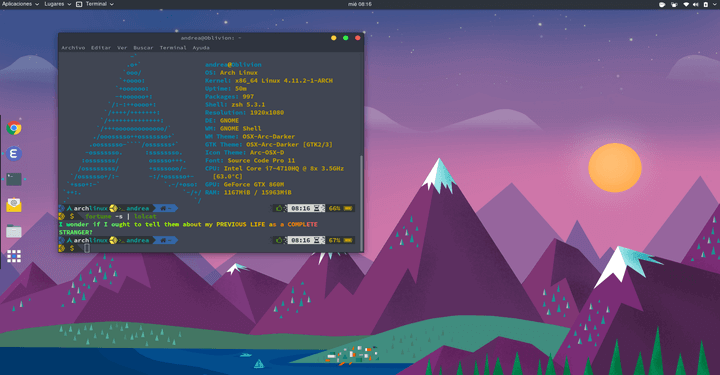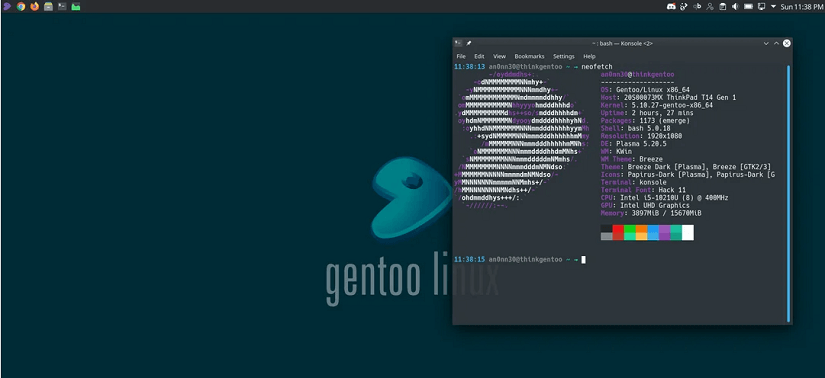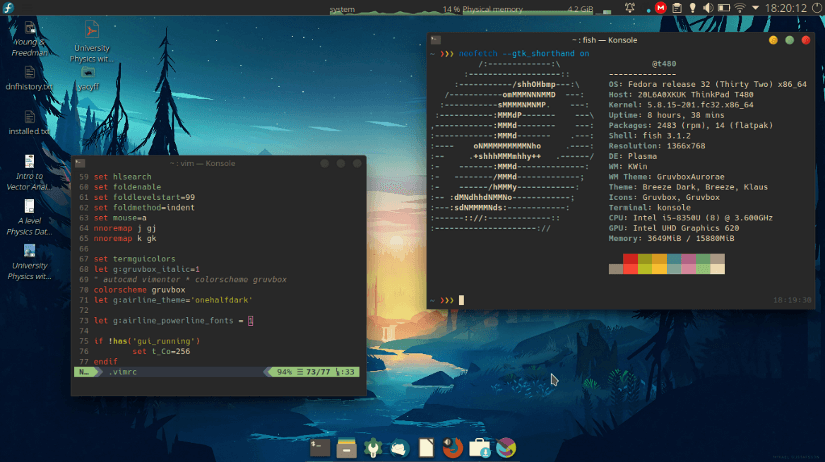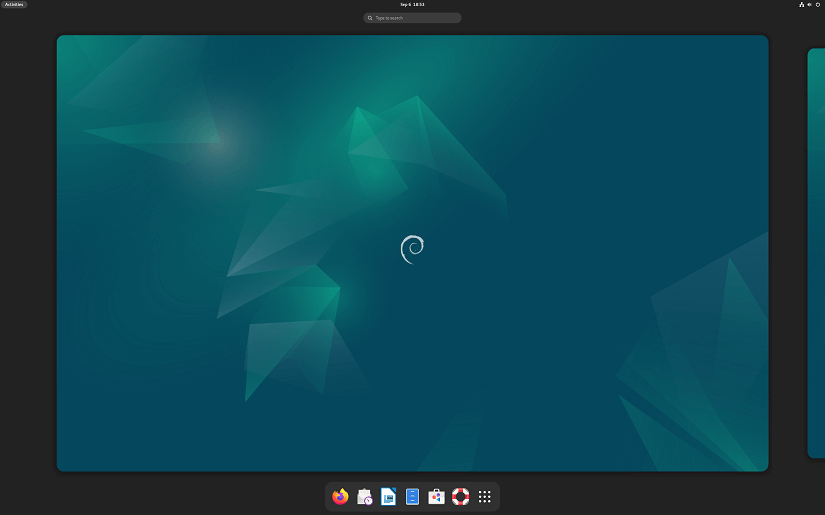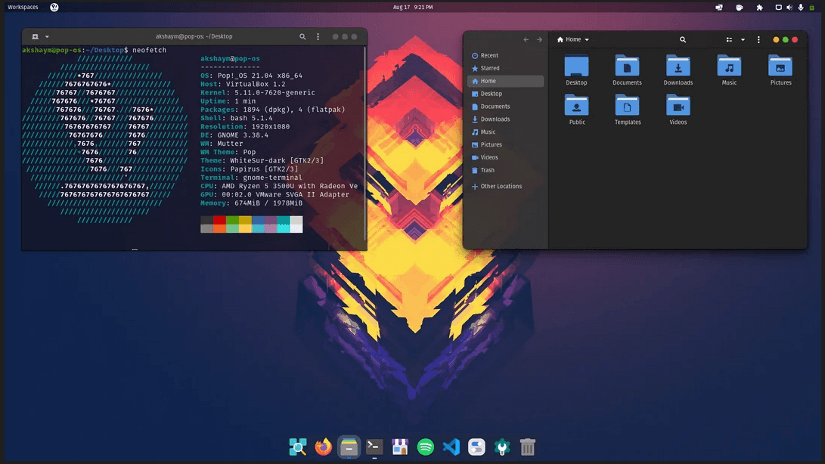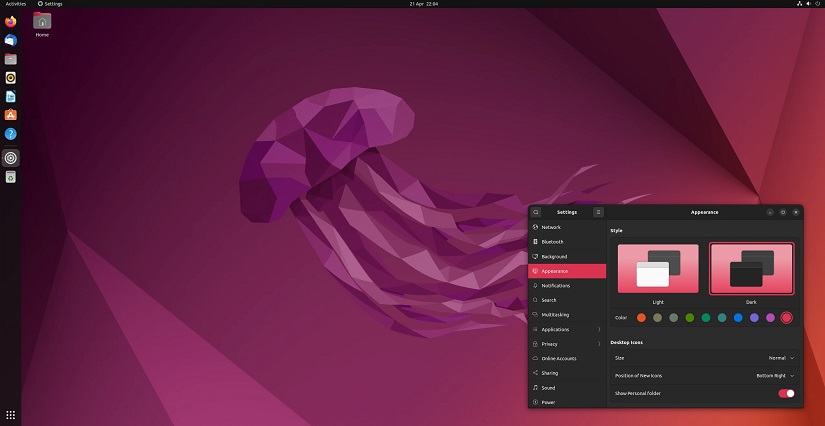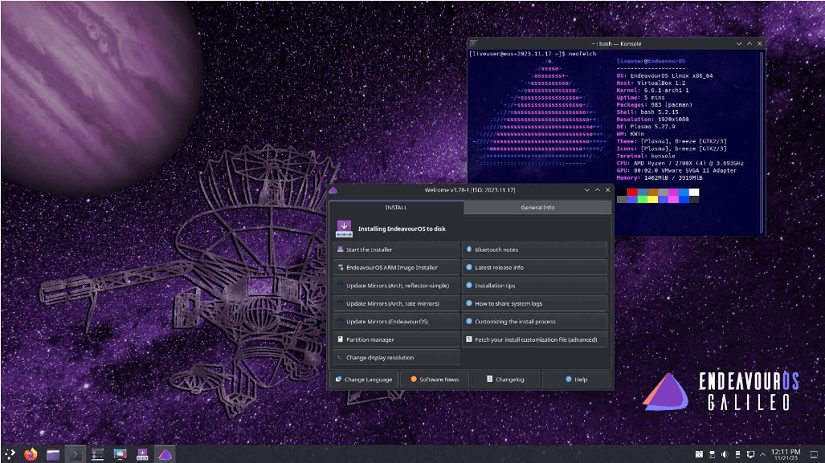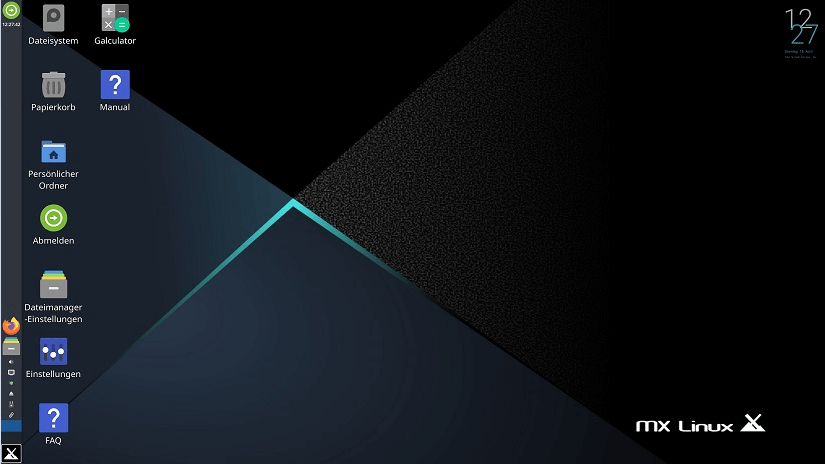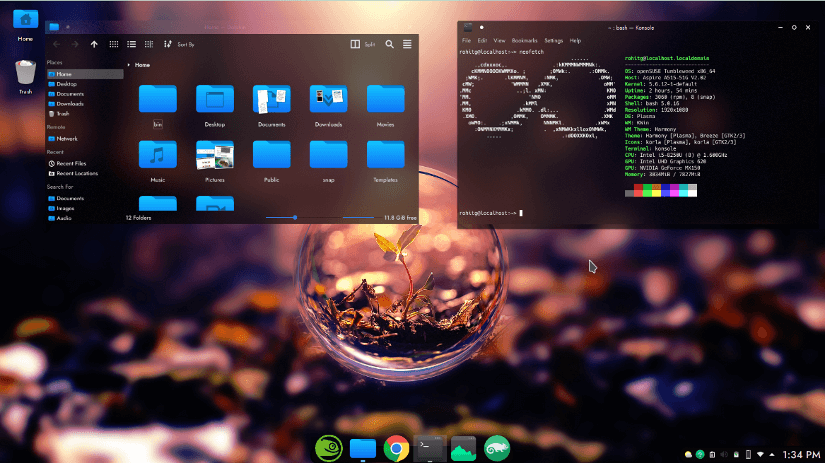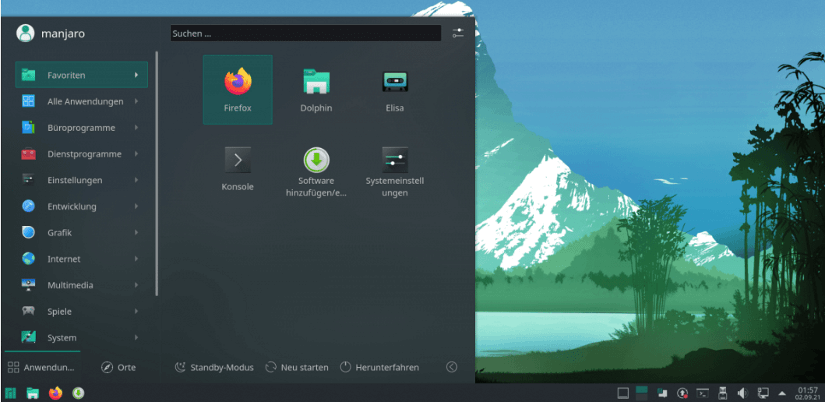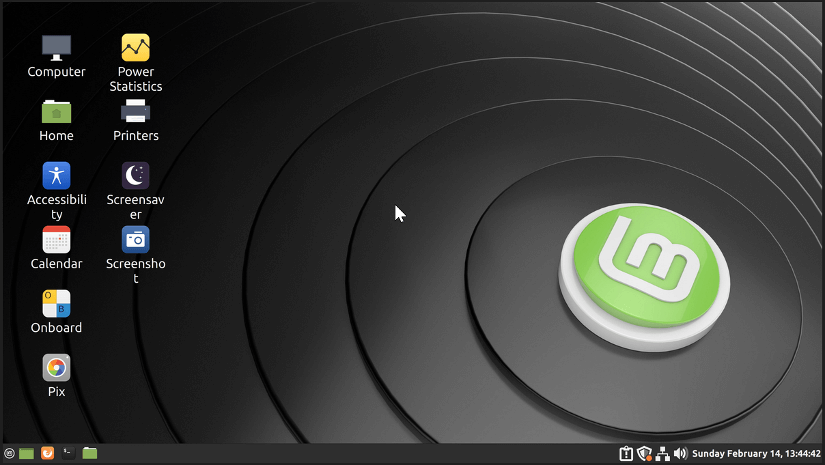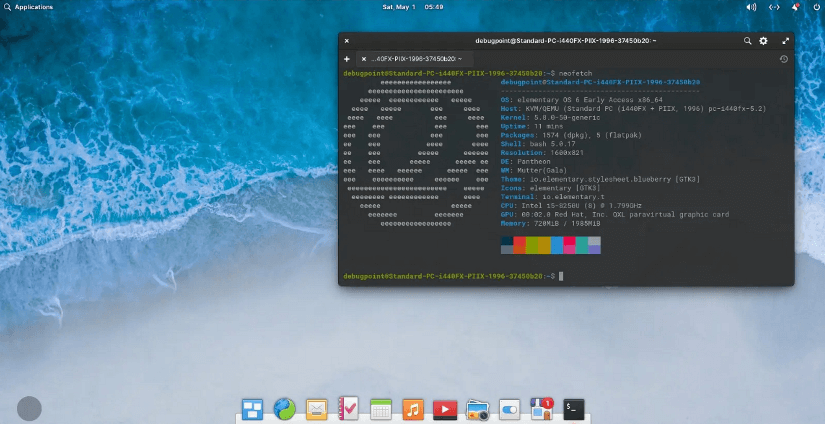FUNDAMENTALS A Complete Guide for Beginners

The Top 12 best Linux distros based on their performance as of 2024 are as follows:
- Arch Linux
- Gentoo
- Fedora
- Debian
- Pop!_OS
- Ubuntu
- EndeavourOS
- MX Linux
- OpenSUSE
- Manjaro
- Linux Mint
- Elementary OS
Choosing the right Linux distribution can significantly impact users’ system performance, whether for a developer, gamer or simply seeking a fast and efficient operating system. In the following writing, I’ll explore these 12 best Linux distro renowned for their performance, each catering to specific needs and preferences. So let’s get started!
1. Arch Linux
Arch Linux is an x86_64-optimized Linux distribution created independently and aimed at proficient Linux users. It employs ‘pacman’, its own package manager, for updating software applications with complete dependency tracking. Utilizing a rolling release model, Arch offers installation options from a CD image or FTP server. Its default installation furnishes a stable foundation for users to tailor to their needs.
Furthermore, the Arch Build System (ABS) facilitates the creation of new packages, adjustment of stock package configurations, and sharing of these packages via the Arch Linux user repository.
Download Arch Linux
Click here to visit Arch Linux‘s official download page.
System Requirements of Arch Linux
- 64-bit x86 processor.
- 512 MB RAM.
- 2 GB hard disk space.
Reasons to Buy Arch Linux
- Highly customizable.
- Lightweight & uses little system resources.
- Rolling release updates.
Reasons to Avoid Arch Linux
- The steep learning curve for beginners.
- No official graphical installer.
2. Gentoo
Gentoo Linux stands out as a highly flexible and rapid Linux distribution, freely available and tailored for developers and network experts. Distinguishing itself from other distributions, Gentoo Linux boasts an advanced package management system known as Portage. Portage mirrors the true ports system seen in BSD, but it’s Python-based and incorporates numerous sophisticated features. Such as dependency handling, precise package management, “fake” installs resembling OpenBSD’s approach, secure package removal, system profiles, virtual packages, configuration file management, and many more.
Download Gentoo
Click here to visit Gentoo‘s official download page.
System Requirements of Gentoo
- CPU i486 or later ( Recommended i686 or later).
- Memory 256 MB ( Recommended 512 MB).
- Disk space 2.5 GB (excluding swap space).
- Swap space at least 256 MB.
Reasons to Buy Gentoo
- Source-based system.
- Top-tier package managers: Portage and emerge.
- Best “init” system: OpenRC.
- Fine-tuning options like USE flags and the ability to switch to clang.
- Supportive community.
Reasons to Avoid Gentoo
- Learning Curve is steeper than other distributions.
- Installation is time-consuming due to its source-based nature.
- Requires frequent manual intervention.
- Limited pre-built packages, lead to longer installation times.
- Not suitable for beginners or those preferring hands-off system management.
3. Fedora
Fedora Linux, developed by the community-supported Fedora Project and owned by Red Hat, prioritizes innovation and early adoption of cutting-edge technologies. It aims to stay at the forefront of open-source advancements. Fedora features the GNOME desktop environment by default, with other options like KDE, Xfce, LXDE, MATE, and Cinnamon available. The custom variations called Fedora spins cater to specific interests such as gaming, security, design, scientific computing, and robotics.
Download Fedora
Click here to visit Fedora’s official download page.
System Requirements of Fedora
- 2GHz dual-core processor or faster (Recommended 2GHz quad-core processor).
- 2GB System Memory (Recommended 4GB).
- 15GB unallocated drive space (Recommended 20GB).
Reasons to Buy Fedora
- Bleeding-edge software and technologies.
- Makes a new version every time a new Gnome version comes out.
- Stable and reliable Red Hat base.
- Active and supportive developer community.
Reasons to Avoid Fedora
- Not recommended for beginners due to potential software instability.
- Not as user-friendly as distros like Ubuntu or Mint.
4. Debian
The Debian Project comprises individuals united to develop a free operating system, known as Debian, which currently utilizes the Linux kernel. Debian offers over 50,000 free packages, covering diverse software needs, from document editing to gaming. It is renowned for its reliability, security updates, and extensive software repository, making it a popular choice for servers, desktops, and embedded systems alike.
Download Debian
Click here to visit Debian’s official download page.
System Requirements of Debian
- Supports 32-bit (i386) or 64-bit (amd64) x86 processors.
- For thin clients 256 MB RAM, and 400 MHz processors are recommended.
- For workstations, 1500 MHz processors, 1024 MB RAM minimum, (Recommended 2048 MB RAM).
- Disk space 60 GB for combined main server + LTSP server + workstation, 40 GB for LTSP server, 30 GB for workstation or standalone, and 4 GB for minimal networked machine installation.
Reasons to Buy Debian
- Known for its stability and dependability.
- Infrequent release cycles make it suitable for long-term use.
- Stable software and long release cycles make it great for servers.
- Committed to being 100% free.
- Runs on different microprocessors.
- One of the oldest and most established Linux distributions.
Reasons to Avoid Debian
- Installing non-free software might be a hurdle for some.
- May lack up-to-dateness, especially for newer hardware.
- Despite improvements, it still has a reputation for being hard to install.
5. Pop!_OS
Pop!_OS is a Linux distribution based on Ubuntu that is developed by System76, a company that produces Linux-powered computers. It is designed to be a user-friendly and customizable OS that is suitable for both new & experienced Linux users.
Download Pop!_OS
Click here to visit Pop!_OS’s official download page.
System Requirements of Pop!_OS
- CPU 64-bit x86, ARM (RAS PI 4) architectures.
- RAM 4 GB (Recommended 8 GB).
- 20 GB drive storage.
Reasons to Buy Pop!_OS
- Automatic, reliable updates ensure stability.
- Ideal choice for high-end users and programmers.
- Custom GNOME environment addresses workflow limitations, enhancing productivity.
- Offers efficient CPU scheduling and fast startup for enhanced productivity.
- Automatic upgrade tool and package/software reinstallation.
Reasons to Avoid Pop_OS
- Outdated installation options for AMD/Intel and Nvidia graphics cards.
- More suitable for experienced Linux users with command shell experience.
- Potential instability due to unexpected crashes.
- Limited integrated software equipment.
6. Ubuntu
One of the most popular & well-known Linux distros is the open-source OS Ubuntu. Maximum new users switching to Linux OS try Ubuntu due to its ease of use, user-friendly interface, large community, wide range of software & lastly, all the free features.
Download Ubuntu
Click here to visit Ubuntu‘s official download page.
System Requirements of Ubuntu
- 2GHz dual-core processor.
- 4 GB system memory (RAM).
- 25GB of free hard drive space.
Reasons to Buy Ubuntu
- Free & open-source distro.
- Lots of free software in the software center.
- Vast community.
- Lots of flavors to suit users’ needs.
- Compatible with most of the hardware.
Reasons to Avoid Ubuntu
- Ubuntu may lack support for some Windows or macOS-specific software.
- Some newer or specialized components might lack proper drivers on Ubuntu.
- Ubuntu’s gaming ecosystem is growing but still behind Windows.
- Ubuntu’s updates can sometimes introduce new bugs or compatibility issues.
7. EndeavourOS
EndeavourOS is a rolling release Linux distribution built on Arch Linux, aspiring to follow in the footsteps of Antergos by delivering a straightforward setup and pre-configured desktop environment atop an Arch foundation. It presents users with both offline and online installation choices. The offline installer utilizes the Xfce desktop environment by default, while the online installer allows the installation of optional software components, including various popular desktop environments.
Download EndeavourOS
Click here to visit Endeavour‘s official download page.
System Requirements of EndeavourOS
- 5 GB of RAM.
- Dual Core Processor (64-bit, x86-64, amd64).
- 15 GB of Harddrive space.
- Recommended to run modern EFI (UEFI) systems not on legacy (CSM) mode.
Reasons to Buy EndeavourOS
- Outperforms MacBook Air with M1 chip in executing tasks like running NodeJS scripts.
- AUR and Pacman offer comprehensive support for research and quick solutions, aligning seamlessly with coding and deployment workflow.
- Simple, fast installation process ideal for both newcomers and experienced users.
- Minimal post-installation steps available on the wiki.
- Responsive community forum providing solutions and guidance.
- Smooth gaming experience with no CPU hiccups during non-intense moments.
- Easy installation of Nvidia drivers and swift access to Steam via pre-configured multilib support.
- User-friendly tools like reflector for optimizing download speeds and GUI package manager for simplified package management.
- Smooths out potential installation issues common with raw Arch setups, ensuring a hassle-free experience.
Reasons to Avoid EndeavourOS
- Offers extensive flexibility but requires deep Linux understanding.
- Minimal handholding during installation may overwhelm newcomers.
- Rolling release model means continuous updates but potential compatibility issues.
- Smaller communities compared to other distributions may affect support availability.
- AUR usage is encouraged, but updates may lag due to unofficial maintenance.
8. MX Linux
MX Linux, a Linux distribution focused on desktop usage and built upon Debian’s “Stable” branch, is a collaborative effort between the antiX and former MEPIS Linux communities. Featuring Xfce as its default desktop environment (alongside optional editions with KDE Plasma and Fluxbox), it stands as a mid-weight OS aimed at blending a sleek and effective desktop experience with customization, stability, reliable performance, and moderate system resource usage. The latest release is MX-23.2 Libretto.
Download MX Linux
Click here to visit MX Linux’s official download page.
System Requirements of MX Linux
- 32/64-bit x86 processor.
- 1GB RAM (2 GB Recommended).
- 5GB hard disk space (20GB Recommended).
Reasons to Buy MX Linux
- Lightweight, fast & easy to use.
- User-friendly.
- Open-source & pre-loaded with natively built apps.
- Stable & customizable.
- Extensive software availability.
- Offers a snapshot feature for creating complete system images that can be booted from a USB on another workstation, facilitating system backup and recovery.
Reasons to Avoid MX Linux
- Some MX updates lack a changelog, making it unclear what changes are being implemented.
- Updating to a new version requires reinstalling the system; automatic updates are not supported.
9. OpenSUSE
Originating from the SUSE Linux operating system, OpenSUSE is based on the RPM Package Management System and uses the YaST configuration tool. It is a free and open-source distribution known for its stability, flexibility & community-driven development. With Zypper as its package management system, OpenSUSE provides both CLI and graphical tools through YaST.
Yet another Setup Tool (YaST) is a powerful configuration tool used in openSUSE that offers a user-friendly experience for managing system settings, applications, and network configurations. It’s supported by the Open Build Service (OBS), where developers can compile packages for multiple Linux distros. OpenSUSE offers multiple desktop environments and two main flavors, Leap and Tumbleweed, with Leap being a point-release distribution and Tumbleweed providing rolling updates with the latest software.
Download OpenSUSE
Click here to visit OpenSUSE’s official download page.
System Requirements of OpenSUSE
- CPU: Pentium 4 1.6GHz or higher (recommended Pentium 4 2.4GHz or higher or any AMD64 or Intel64).
- RAM: 1GB, (recommended 2GB).
- Storage: 10GB (minimal installation), 16GB for graphical desktop (recommended 40GB) of free disk space.
Reasons to Buy OpenSUSE
- Community-driven project.
- Maintains OS integrity with multiple desktop environments.
- Unique software delivery method.
- Comprehensive control center with YaST.
- Excellent hardware support.
Reasons to Avoid OpenSUSE
- Software packages are not always the latest version.
- Some are following EU and non-GPL regulations very strictly.
- Frequent package updates sometimes break proprietary programs.
- Reasons to Avoid OpenSUSE Leap are transition to ALP (Adaptable Linux Platform) and dependency on community contributions.
10. Manjaro
Manjaro Linux, derived from Arch Linux, stands out as a rapid, user-centric, desktop-focused OS. It offers an intuitive installation procedure, automated hardware recognition, a dependable rolling-release system, support for multiple kernels, dedicated Bash scripts for graphics driver management, and extensive desktop customization capabilities. Core desktop choices include Xfce, alongside KDE, GNOME, and a minimalist Net edition tailored for advanced users. Additionally, community-backed desktop variants are also available.
Download Manjaro Linux
Click here to visit Manjaro Linux‘s official download page.
System Requirements of Manjaro Linux
- 4GB of memory.
- 30GB of hard disk space.
- A dual-core processor.
Reasons to BuyManjaro Linux
- Offers a highly responsive experience with occasional minor issues.
- Recommended for both adventurous beginners and seasoned users exploring a secondary distribution.
- Manjaro’s software manager is robust, offering access to AUR repositories.
- Swift performance without obstacles, even on dated hardware.
Reasons to Avoid Manjaro Linux
- Rolling Release can lead to stability issues.
- The Arch User Repository (AUR) can cause dependency problems.
- May require more maintenance than other distributions.
- Sometimes requires manual user intervention.
- Some applications might be only available on other distributions like Ubuntu.
11. Linux Mint
Linux Mint is a perfect Ubuntu-based distro for beginners due to its Windows-like familiar interfaces. Moreover, it performs great with older hardware and gained improvements over Ubuntu over time. The popular Linux Mint edition is the Linux Mint Cinnamon. The latest release is Linux Mint 21.3 Virginia.
Download Linux Mint
Click here to visit Linux Mint‘s official download page.
System Requirements of Linux Mint
- 2GB of RAM (4GB recommended).
- 20GB of free disk space.
- 1024×768 resolution.
- Dual-core CPU.
Reasons to Buy Linux Mint
- An excellent choice for beginners as it’s known for its simplicity and ease of use.
- Available with a choice of desktop environments, including Cinnamon, MATE, and Xfce.
- Includes a range of multimedia codecs and plugins, making it possible to play a wide range of audio & video formats.
- Light on system resources with great stability.
- Has a larger user & developer community.
- Has a wide range of tools & utility applications.
Reasons to Avoid Linux Mint
- Might not be compatible with all programs or games.
- No proprietary drivers such as NVIDIA, or ATI, are not included but can be installed via Drive Manager.
- Some software may be outdated due to less frequent updates.
- Doesn’t include Snap by default but can be added easily.
12. Elementary OS
Elementary OS, a desktop distribution built upon Ubuntu, stands out with its unique features. These include a custom desktop environment known as Pantheon and a suite of custom applications like Photos, Music, Videos, Calendar, Terminal, and Files. Additionally, it includes familiar applications such as the Epiphany web browser and a modified version of the Geary mail client.
Download Elementary OS
Click here to visit Elementary OS‘s official download page.
System Requirements of Elementary OS
- Recent Intel i3 or comparable dual-core 64-bit processor.
- 4 GB of system memory (RAM).
- Solid state drive (SSD) with at least 32 GB of free space.
- 1024×768 minimum resolution display.
- You will also need a spare USB flash drive with at least 4 GB of storage for installation.
Reasons to Buy Elementary OS
- Sleek and intuitive interface.
- Consistent user experience.
- Built-in productivity tools.
- Focus on privacy and security.
- Regular updates and support.
- Pay-what-you-want model.
Reasons to Avoid Elementary OS
- Slow update cycle.
- Limited software availability.
- Potential compatibility issues.
- Uncertainty regarding the funding model.
- Small development team.
- Limited user community.
Comparison of Best Linux Distros Based on Performance
To get a comparative overview of the 12 best Linux distros based on performance that have been discussed so far in this article, kindly go through the following table:
| Name | Features | Package Manager | Release Model | Customization ability | Average User Rating |
|---|---|---|---|---|---|
| Arch Linux | Minimalist design, customization, and control | Pacman | Rolling | High | 9.3 |
| Gentoo | Extreme customization and optimization | Portage | Rolling | Very high | 8.4 |
| Fedora | New technologies and security | DNF | Regular | Moderate | 8.2 |
| Debian | Stability and wide hardware support | APT | Stable | High | 8.9 |
| Pop!_OS | Optimized for developers and gamers | APT | Regular | Moderate | 8.0 |
| Ubuntu | User-friendly with extensive software availability | APT | LTS and regular | High | 7.7 |
| Endeavour OS | Arch-based with friendly installer | Pacman | Rolling | High | 8.4 |
| MX Linux | Lightweight and efficient | APT | Stable | Moderate | 8.1 |
| OpenSUSE | Robust system configuration and Btrfs support | Zypper | Leap (stable), Tumbleweed (rolling) | High | 8.7 |
| Manjaro | Arch-based with user-friendly features | Pacman | Rolling and stable editions | High | 8.1 |
| Linux Mint | User-friendly and stable | APT | Regular | High | 8.7 |
| Elementary OS | Aesthetic-focused with intuitive design | APT | Regular | Moderate | 4.9 |
Note: The average user ratings are based on the user ratings provided on Distrowatch up until 13th February 2024.
Conclusion
In conclusion, there are many Linux distributions designed for speed, stability, or simplicity. It might be overwhelming but not that difficult to find one that suits your needs. Try out different ones and find the best match for you. Hope this article helps you choose the best-performed distro for your system.
People Also Ask
Which is the best Linux for performance?
Determining the best Linux distribution for performance depends on various factors such as hardware compatibility, user preferences, and specific use cases. However, several distributions are often praised for their performance, such as Arch Linux, Gentoo, Fedora, Ubuntu, Manjaro, etc.
What is the best Linux distro for high performance computing?
For high-performance computing (HPC), several Linux distributions are well-suited due to their focus on performance, scalability, and support for advanced computing environments. Some of the best Linux distributions for HPC include Debian, Ubuntu Server, Rocky Linux, Arch Linux, SUSE Linux Enterprise, etc.
Which Linux distro has the best gaming performance?
Some of the best Linux distros for gaming are Pop!_OS, Garuda Linux, Drauger OS, Ubuntu GamePack, Lakka, and Sparky GameOver.
Is Debian faster than Ubuntu?
In a simple installation, Debian tends to be faster due to its lightweight design. On the other hand, Ubuntu tends to act faster, smoother, and quicker on the latest computing machines. So to choose between these two, if you prioritize stability and reliability, Debian is an excellent choice. And, if you want a balance between stability and new features, Ubuntu’s LTS releases are a good fit.
Which is the powerful Linux?
When it comes to powerful Linux distributions, there are several options to consider based on your needs. Some of the powerful Linux distros are, Nitrux, best for new users, Linux Mint, suitable for beginners as the default Cinnamon desktop resembles the layout of the Windows system23, Manjaro, a Linux-based open-source operating system that does not require users to pay a fee or display ads, OpenSuse Leap, geared towards professional use. Elementary OS, is one of the most beautiful Linux distros as the UI resembles that of macOS. Ubuntu, One of the most popular Linux distributions, Fedora OS, is known for its cutting-edge features, Zorin is known for its ease of use and simplicity, and Debian is known for its stability.
Which Linux is best for programming?
Selecting a Linux distribution for programming and data science is crucial, taking into account factors such as hardware compatibility, package management, community support, available tools, stability, customization options, security features, and user interface. Commonly favored options include Ubuntu, Fedora, Debian, Arch Linux, CentOS, Manjaro, Linux Mint, and openSUSE. Among these, Linux Mint and Ubuntu are frequently regarded as top choices among newcomers coming into programming, due to their user-friendly interfaces and large community support resources.
